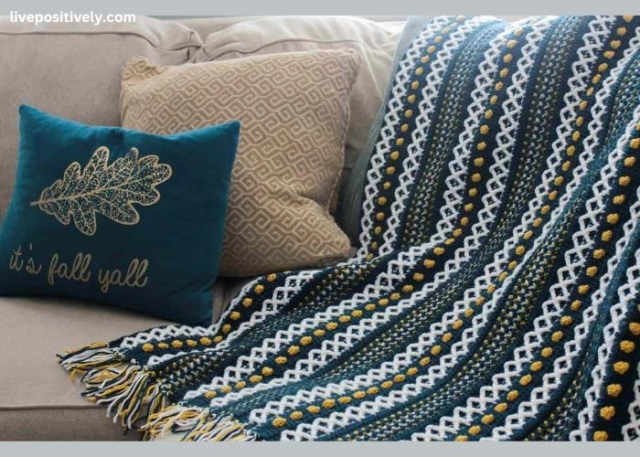Crocheting a blanket is an excellent project for beginners looking to dive into the world of fiber arts. It's a rewarding endeavor that allows you to create something both beautiful and functional while honing your skills. In this comprehensive guide, we'll explore why blankets are ideal starter projects, discuss time frames, cover essential techniques, list required materials, and provide some easy crochet patterns to get you started on your crochet journey.
Why Start with an Easy Crochet Blanket?
There are several compelling reasons to choose a blanket as your first major crochet project:
- Simple, repetitive stitches: Most beginner blanket patterns utilize basic stitches like single crochet or double crochet, allowing you to practice and perfect these fundamental techniques.
- Forgiving of mistakes: Unlike garments that need precise shaping, small errors in a blanket are often unnoticeable in the finished product.
- No complicated shaping: Blankets are typically worked in simple rectangles or squares, eliminating the need for increases, decreases, or intricate shaping.
- Sense of accomplishment: Completing a blanket provides a great sense of achievement, motivating you to continue with your crochet journey.
- Practical and useful: Unlike some beginner projects that may not see much use, a blanket is a functional item you can enjoy for years to come.
- Customizable: Blankets can be easily adapted in size and color to suit your preferences or needs.
How Long Does It Take to Crochet a Blanket?
The time it takes to crochet a blanket can vary widely depending on several factors:
- Size of the blanket: Naturally, larger blankets take longer to complete. Here's a rough estimate:
- Baby blanket (30" x 36"): 12-20 hours
- Throw blanket (50" x 60"): 40-80 hours
- Twin size blanket (66" x 90"): 100-150 hours
- Queen size blanket (90" x 100"): 150-200 hours
- Complexity of the pattern: Simple patterns using basic stitches work up more quickly than those with intricate stitch combinations.
- Yarn weight: Thicker yarns generally work up faster than thinner ones. Using a super bulky yarn can significantly reduce project time.
- Your skill level and speed: As you gain experience, you'll likely crochet faster.
- Time dedicated to the project: How many hours per day or week you can devote to crocheting will impact the overall timeline.
For a beginner working on a throw-sized blanket with a simple stitch pattern, you might expect to spend about 40-80 hours total. This could translate to 4-8 weeks of regular crocheting sessions, assuming you crochet for about 1-2 hours per day.
Techniques You Will Use
When crocheting a beginner-friendly blanket, you'll typically use these basic techniques:
- Chain stitch (ch): This forms the foundation of your blanket and is used to start each row.
- Single crochet (sc): A basic stitch that creates a tight, sturdy fabric.
- Double crochet (dc): Works up faster than single crochet and creates a looser, more drapey fabric.
- Half double crochet (hdc): A versatile stitch that's a good middle ground between sc and dc.
- Changing colors: If your pattern includes stripes, you'll learn how to switch yarn colors.
- Weaving in ends: This technique secures loose yarn ends for a neat finish.
- Basic edge or border: Many blanket patterns include a simple border to give a polished look.
Materials Needed for this Blanket Crochet Pattern
To get started on your beginner crochet blanket, you'll need:
- Yarn: Choose a medium weight (worsted) yarn for your first project. Acrylic yarn is often recommended for beginners as it's affordable and easy to work with.
- Crochet hook: The size will depend on your yarn choice, but for worsted weight yarn, a size H/8 (5mm) or I/9 (5.5mm) hook is typical.
- Scissors: Any sharp scissors will do for cutting yarn.
- Tapestry needle: Used for weaving in ends.
- Stitch markers: These help keep track of your stitches and rows.
- Measuring tape: Useful for checking your gauge and blanket size.
For a throw-sized blanket (approximately 50" x 60"), you'll typically need about 8-10 skeins of worsted weight yarn.
Easy & Free Crochet Blanket Patterns
Here are some simple crochet blanket patterns perfect for beginners, along with detailed descriptions to help you choose the right project for you:
- Simple Striped Blanket: This pattern uses only single crochet stitches and simple color changes to create a modern striped design. It's an excellent way to practice maintaining even tension and changing colors. The pattern typically involves crocheting rows of single crochet, changing colors every few rows to create stripes. You can customize the width of the stripes and the color combination to suit your taste. This pattern is ideal for absolute beginners as it only requires knowledge of one basic stitch.
- Granny Square Blanket: Learn the classic granny square technique and join them to create a colorful blanket. This pattern teaches you how to work in the round and join motifs. Granny squares typically consist of clusters of double crochet stitches worked into a chain-space of the previous round. You'll make multiple squares and then join them together to form the blanket. This project is great for learning how to work in the round and how to join pieces together.
- Chunky Throw Blanket: Using super bulky yarn and a large hook, this blanket works up quickly and is extra cozy. It's perfect for those who want to see fast results. The pattern usually involves simple stitches like double crochet or half double crochet worked in rows. The thick yarn and large hook size mean you'll see progress quickly, which can be very motivating for beginners.
- Moss Stitch Baby Blanket: This simple stitch pattern creates a beautiful texture and is easily adaptable to larger sizes. It's a great introduction to combining basic stitches for interesting effects. The moss stitch (also known as the linen stitch or granite stitch) is created by alternating single crochet and chain stitches. This pattern teaches you how to create texture with simple stitches and is excellent for practicing stitch placement.
- Corner-to-Corner (C2C) Blanket: This technique creates a diagonal texture and is surprisingly easy for beginners. It's an excellent way to practice increasing and decreasing. C2C blankets are worked from one corner to the opposite corner, creating a unique diagonal pattern. This technique is great for making graphghan-style blankets with pictures or words incorporated into the design.
- Ripple Blanket: This classic pattern creates a wavy design using simple increases and decreases. It's a step up from completely straight edges but still beginner-friendly. The ripple pattern typically uses double crochet stitches with periodic increases and decreases to create the wave effect. This pattern helps you learn how to shape your work while still using basic stitches.
- Solid Shell Stitch Blanket: This pattern introduces the shell stitch, which creates a lovely textured effect while still being easy to master. Shell stitches are typically made up of multiple double crochet stitches worked into the same stitch of the previous row. This pattern helps you learn how to create decorative stitches and is a good introduction to more complex stitch patterns.
When choosing a pattern, consider your skill level and the time you have available. Start with simpler patterns and work your way up to more complex ones as your skills improve. Remember, the key is to enjoy the process and learn as you go.
Conclusion
Crocheting your first blanket is an exciting and rewarding experience. It's a project that allows you to practice fundamental techniques while creating something beautiful and useful. Remember, the key to success is patience and persistence. Don't worry if your first attempts aren't perfect - each stitch is a learning opportunity, and your skills will improve with practice.
As you work on your blanket, you'll likely find your tension improving and your stitches becoming more even. You may discover a meditative quality to the repetitive motions of crocheting, making it a relaxing and enjoyable hobby. Before you know it, you'll have a cozy blanket to snuggle under or give as a heartfelt gift.
Starting with a simple blanket pattern sets you up for success in your crochet journey. It builds your confidence, teaches you essential skills, and gives you a solid foundation for tackling more complex projects in the future. So grab your hook and yarn, find a pattern that speaks to you, and start creating your very own crochet blanket.






